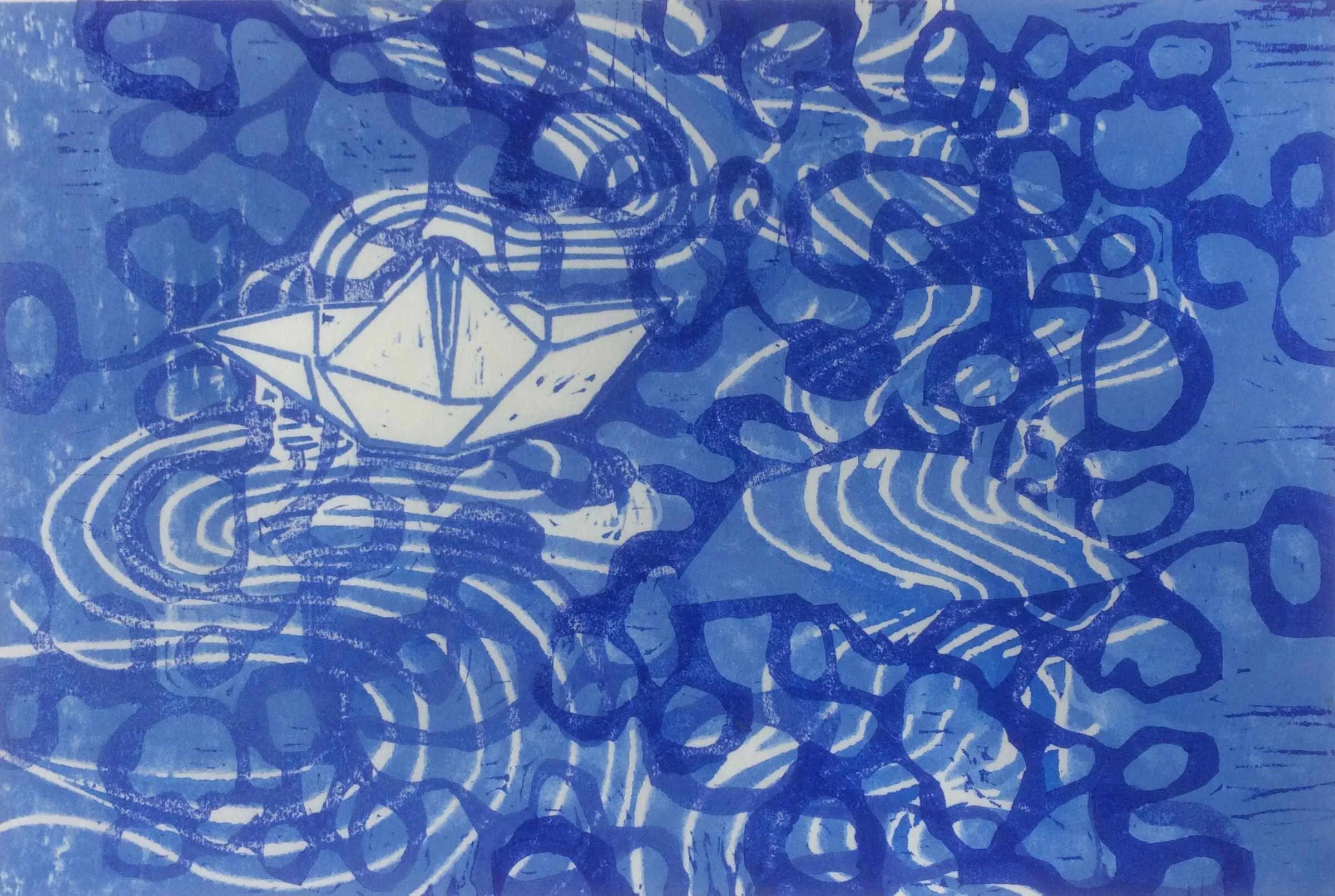Carborundum
Carborundum is a printmaking technique that uses gritty material mixed with a binder, like glue or varnish, to create areas of rich tone and texture. This flexible surface allows experimenting with scribing tools, expressive mark making and drawing. Printing plates can be made on a wide range of materials including wood, plastic or metal and the gritty surface produces strong, richly coloured prints.
Collagraph
Most collagraphs are essentially printed collages. Different types of sheet material can act as a base , like wood, cardboard, metal or plastic. All of these can be cut, shaped and incised with different tools. Flat materials like wallpaper, fabric, textured and organic material can be glued onto the surface. The resulting images can be printed in relief from the surface, printed from the recesses (intaglio) and may also be printed as embossed images without colour.
Drypoint
Drypoint is the simplest and most direct of the intaglio (incised) printing techniques. It is an excellent way to create images, as no acids or complex procedures are involved in making the plate.
Using any sharp point or abrasive tools, marks and lines are scratched onto a sheet material, like plastic or soft metal; the grooves are then filled with ink and printed under extreme pressure on an etching press.
Etching
The most common type of etching is done on a metal plate. There are many etching techniques including hard ground, soft ground, aquatint and several more. In printmaking what they all have in common is that part of the surface is removed by chemical means. The chemicals ‘bite’ the images into the plate creating all manner of lines and recesses. The plate is then covered in ink, the surface wiped clean and the ink left in the recesses is transferred under extreme pressure onto paper. Like engraving and drypoint, etching is an ‘intaglio’ process, where the design is sunk into the surface.
Japanese Style Woodcutting - Mokuhanga
This is an ancient traditional technique, water based, non-toxic, absorbing and accessible. A number of colour blocks (iro-ban) are carved, painted and then printed one after the other onto damp Japanese washi paper. The kentou registration system ensures that the blocks are printed accurately every time.
The one day workshop is an intensive introduction using simple, prescribed design elements.
The two day workshop allows more time to explore all the processes in greater detail with more complex images.
Both are suitable for beginners and those with some experience.
Woodblock printmaking is a highly refined aspect
of Japanese culture.
Life model & Still Life
Working directly from a life model or still life arrangement, has a long tradition in printmaking. Rembrandt, Morandi, Whistler, Barbara Rae, Lucien Freud and countless others, have explored their ideas through the power of print. While the work is demanding and challenging, it allows freedom to experiment with materials and processes that often produces unexpected results.
Lino Cutting
The most common linocut uses a single sheet of linoleum for the design and is printed in a single colour.
A single sheet can also be cut in a series of stages to produce a multi-coloured reduction print. After each stage of cutting a different colour is printed. This can be done many times to build the finished print. What is left of the linoleum is discarded.
Images can also be produced as colour separations using several cut plates to produce a multi-coloured print. The separations allow repeat printings of the design.
Monotype and Mono-print
In printmaking, adding and subtracting ink from a flat surface produces a Monotype print. This highly creative process, allows the ink to be applied with rollers, brushes, rags, stencils or by other means. Images are printed by hand or using a printing press. All images are unique.
A Mono-print plate already has an image on it created by another printmaking technique, like collagraph or etching. Combining this image with the inking methods of monotype, allows artists to create unique prints that incorporate their ideas as unique variations. .
Photo-Etching
Photo etching is an exciting and fascinating technique that allows photographic images, drawings and collages to be made into high-quality intaglio prints. The process can be used on its own or in conjunction with other printmaking methods.
Chine Collé
This translates from French as “chine” - tissue, and “collé” - glue or paste.
This special technique allows the inclusion of different fine papers, printed images, colours and textures to be adhered to individual prints, during the printing process. The paper, usually in pre-cut shapes, is therefore not just glued as a collage element, but is actually bonded to the paper of the print under pressure.
Wood Engraving
A wood engraving is a type of relief print and one of the most exquisite and detailed forms of printmaking.
The image is cut from the mirror-smooth surface of a block of end grain wood. Boxwood is best, though cheaper alternatives such as lemonwood and synthetic materials are now frequently used.
Once the design is engraved, the cuts that were made in the wood come out as white when the remaining surface is inked and printed.
Most wood engravings tend to be closely worked and relatively small because the tools are designed for extremely fine detail.
Woodcutting
Woodcutting is a relief printing technique where the image is cut on the grain of the wood, often in plank form - unlike wood engraving, where the block is cut in the end grain.
Any kind of flat wood is suitable to use including industrial grade sheet material. Very large work can be undertaken, plates can be sawn and shaped with power tools and plates can be printed by hand instead of through a press. This flexibility in size, shape and materials makes it a very popular and important medium for printmakers.












